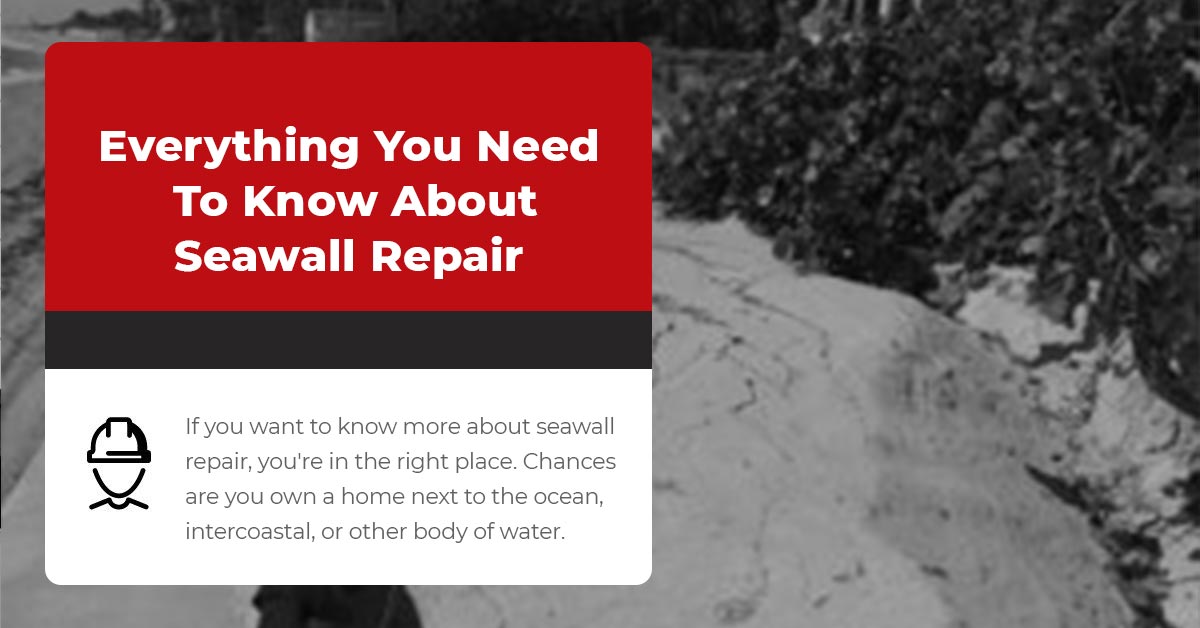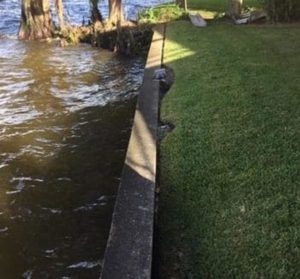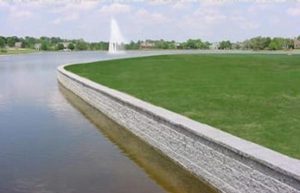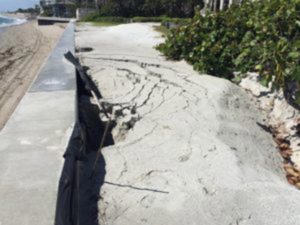If you want to know more about seawall repair, you’re in the right place. Chances are you own a home next to the ocean, intercoastal, or other body of water. The edge of your property that touches the water is protected by a seawall. This concrete wall prevents your property from
erosion and keeps rising water levels from flooding your land.
What Is Seawall Repair?
Seawall repair involves fixing bowing, leaning, misaligned, cracked, or deteriorating seawalls. Seawalls protect your property from water erosion. But, the walls themselves can erode away as it’s exposed to saltwater, harsh weather, age, expansive soil, and settlement. Seawalls have an average lifespan of 30 to 50 years before they require any serious maintenance.
Seawalls are expensive to build, and if you allow them to degrade, you could risk a lot more than the cost of repairing them. So, if you notice any of the following signs, call a seawall professional now.
- Bowing or leaning – If your seawall is bowing or leaning toward the body of water, chances are the soil behind it is saturated with water. When water builds up in the soil behind your seawall, the increase in soil density will push against your seawall. This will lead to cracks and shifts that allow water to get behind the seawall, causing further damage.
- Misalignment – A misaligned seawall indicates deterioration due to harsh weather or aging. Hurricanes, floods, and waterspouts can seriously damage the concrete wall, shifting it out of place.
- Cracks – Bowing or leaning seawalls usually lead to horizontal cracks. These cracks allow water to seep into your property, leading to voids and erosion. Pay attention to cracks that form on the seawall cap (the top of the seawall) as well.
- Deterioration – Overtime, salt water, harsh weather, and age can eat away at the concrete that makes seawall. With enough erosion, the steel rebar inside the concrete could be exposed to the elements and rust, compromising the entire structure.
- Corroded or exposed tiebacks – Most seawalls are anchored to your property using tiebacks. These anchors keep your seawall connected to your soil and prevent the concrete from leaning into the water. However, these tiebacks can rust, corrode, or become exposed by erosion, causing the seawall to fail.
All of these issues require professional attention and solutions. We do not recommend taking on any of these repair projects yourself. In most cases, cities require permits before anyone works on seawalls to minimize property damage.
Seawall Repair Solutions
If professionals determine that your seawall can be repaired without replacing the entire structure, they’ll likely use targeted grout injections, epoxy injections, or helical tieback anchors.
- Targeted Grout Injections (TGI) – Professionals can inject polyurethane resin into the soil behind the seawall, filling underground voids and stopping leaks. This resin is an extremely thin liquid that reacts with the moisture inside the soil, forming a solid, rock-hard, and waterproof mass.
- Epoxy Injections – Any cracks that form on your concrete seawall can be filled and sealed using an epoxy injection. This will prevent water from seeping through your concrete and eroding the soil kept behind.
- Helical Tieback Anchors – The same type of anchors that straighten basement walls can also be used to pull bowing or leaning seawalls back into place. The anchors are composed of a steel rod, plate, and screw. The screw is attached to the rod once it’s inserted through the exterior of your concrete. The last piece is a steel plate that’s secured to your wall. The anchors are drilled through the soil behind your wall until the plates pull your wall back inward, correcting the bowing and leaning. Helical tieback anchors are installed with a machine that sits on your property, so there is no interference with the water. These anchors can be used on new seawalls and seawall repairs.
None of these solutions are DIY projects. If your seawall needs repair, you need to contact professionals with years of experience. Leaving your seawall to fail will lead to property erosion and flooding. Once water levels rise or a new hurricane hits, your seawall could fail and cost you thousands of dollars to repair. Act on these signs before they get worse and save yourself time, money, and stress.
Who To Call For Seawall Repair
If you live in the Southeast United States and need seawall repair, call Foundation Professionals of Florida. Our team of experts have fixed thousands of seawalls across our service area. We’ll inspect your seawall for free, find out what needs to be repaired, and choose the solution that does the job. Don’t wait. Call now!




